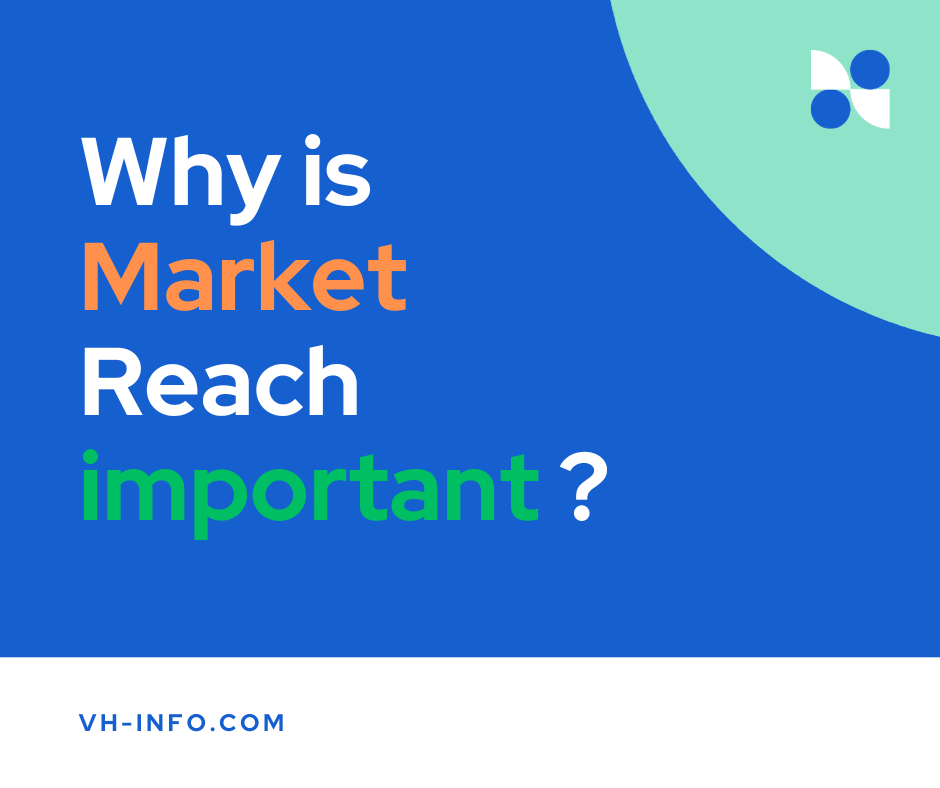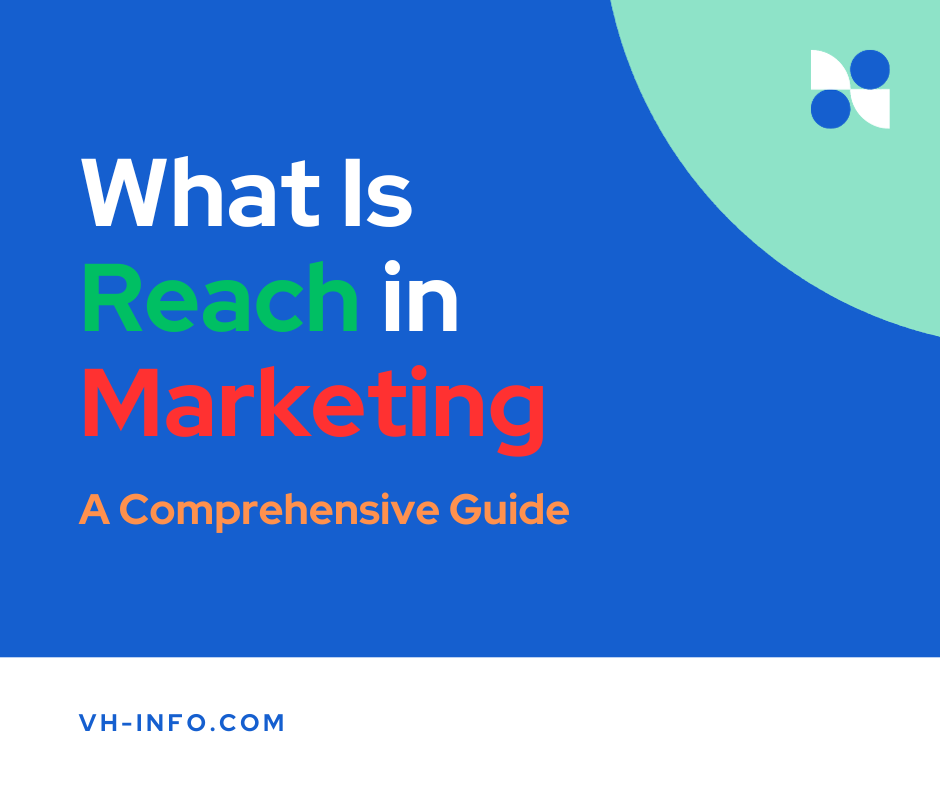As a marketer, you know that one of the biggest challenges is to reach your target audience. That’s where reach marketing comes in.
Reach can be defined as the total number of people who have seen your message or content – whether it is an ad, a post, or an email.
Understanding how to calculate and use market reach strategically can help you create effective campaigns and maximize your ROI, ultimately reaching a broader audience.
In this blog from VH-info, we will provide a comprehensive guide on what is reach in marketing, why it is important, how to calculate it, and how to use it strategically in your social media marketing strategy.
We will also discuss impressions in marketing and the difference between reach vs impressions on different social networks like Facebook, Instagram, TikTok, LinkedIn, Twitter, YouTube, Pinterest, and Snapchat.
Plus, we’ll give some examples of successful social media reach marketing campaigns that can provide valuable insights for businesses to improve their targeting and engagement levels.
What is Reach in Marketing?
Reach refers to the number of people who are exposed to a marketing message or ad campaign. It measures the audience size and indicates how many people had the opportunity to see an ad or content. The greater the reach, the more people a marketing campaign can potentially influence. Marketers aim to maximize reach to get their message and brand in front of as large an audience as possible.
However, high reach alone does not guarantee that the campaign will be effective. The target audience and their level of engagement also play a key role. Overall, reach gives marketers a sense of the potential scale and exposure of their efforts.
What is Reach in Social Media?
In social media, reach refers to the number of unique users who see a particular post or piece of content. It measures the size of the audience exposed to a post. A post’s reach indicates how many different accounts had that content delivered to their feed, showing the potential number of users that saw the post.
A high reach suggests content is being shown to a wide range of users and a high number of unique people. However, it does not account for how many people actually engaged with the post. Reach gives social media users and marketers a sense of the potential scale and dissemination of their content across the social platform. The higher the reach, the more users are being exposed to the messaging.
Why is Market Reach important?

Here are a few reasons why market reach is important for businesses:
- Wider reach expands customer base – A broader reach allows businesses to get their product or service in front of more potential customers. This increases the chances of gaining new customers.
- Creates brand awareness – High market reach helps create awareness about the brand and its products to a larger audience. This can help with brand recognition and recall.
- Drives growth – More reach typically means more sales and revenue. The more people that are aware of and can buy your product, the more opportunities for growth.
- Achieves marketing goals – Reach enables businesses to achieve key marketing goals like engagement and conversions at a bigger scale. The wider the reach, the more impact marketing campaigns can have.
- Enhances competitiveness – Good reach helps businesses compete with others in their market. It prevents losing customers to competitors who may be reaching a wider audience.
- Provides useful data – The reach metrics also give useful insights into audience interest and marketing effectiveness that can inform strategy.
- Cost-effective – Getting in front of target customers at scale in a cost-efficient manner is critical for successful marketing. Broad reach allows just that.
How to calculate Reach Marketing?

To calculate Reach Marketing follow the steps below:
Find your impressions
Impressions refer to the number of times your ads were seen or served.
To calculate reach, you first need to know the impressions for your ad campaign, also known as Facebook impressions. This data is available in your marketing analytics platforms like Google Analytics or Facebook Ads Manager. Total impressions simply means the total number of times your ads were displayed, which is an important factor in determining your Facebook reach.
The formula for calculating impressions is:
(Ad spend / CPM) x 1000 = Impressions
Determine your ad campaign’s frequency
Frequency tells you how many times on average a person saw your ad. It is calculated by total impressions divided by reach.
For example, if your campaign had 1 million impressions and reached 100,000 people, the frequency is 1 million/100,000 = 10. This means each person saw your ad 10 times on average. Higher frequency may indicate excessive ad displays.
The formula for determining frequency is:
Impressions / Unique users = Frequency
Calculate market reach
Once you have impressions and frequency, you can calculate the campaign’s reach. This is done by dividing total impressions by the frequency.
For example, if you had 1 million impressions at a frequency of 10, then reach is 1 million/10 = 100,000. This means your campaign reached 100,000 unique users, even though it had 1 million impressions. Reach is a key metric as it indicates the size of the audience exposed to your marketing message and helps to avoid ad fatigue.
The formula for calculating reach marketing is:
Impressions / Frequency = Market reach
How to Use Market Reach Strategically?

- Determine your target audience: Clearly define who your ideal customers are. Gather demographic, geographic, behavioral, and psychographic data on them. This will allow you to optimize reach to the audiences most likely to convert.
- Learn how your potential customers interact with media: Research where and how your target audience engages with marketing content. This could be through TV, radio, emails, social media, etc. Then focus your efforts on those high-value channels.
- Use multichannel marketing strategies: Employ a cross-channel approach across digital, print, social media, events, etc. This allows you to maximize reach by tapping into multiple touchpoints. Omnichannel coordination also helps boost engagement.
- Identify your ideal frequency: Figure out the optimal ad frequency through testing. Balance reach against excessive frequency that may irritate audiences. Adjust campaigns to hit the ideal frequency that drives responses.
- Track market reach alongside other relevant metrics: While reach is important, combine it with metrics like engagement rate, conversions, costs, etc. to get a complete picture. This enables data-driven decisions to refine strategies.
How to use Market Reach Strategically in response to link building?
Here are some tips for using Market Reach strategically in response to link building:
- Focus on high-quality sites in your target market: When building links, prioritize getting links from authoritative, relevant sites in your industry. These links will be seen as more valuable by Google and can improve your domain authority.
- Leverage existing brand awareness and content: If you already have good brand recognition and high-quality content assets, use those as hooks to earn links from industry sites. For example, offer guest posts from your executives, infographics on market data, or data from an annual report.
- Get creative with link opportunities: Look beyond traditional link building like guest posts and influencer outreach. Sponsor industry events, run social campaigns that link back to your content, or see if any local organizations want to link to your community resources.
- Build relationships over time: Don’t just spam sites asking for a link. Develop connections with authors, influencers, and site owners in your market. Provide value to them through content sharing and social promotion. Links will develop naturally over time.
- Monitor new sites in your market: Keep an eye out for new sites, magazines, blogs popping up in your space. Reach out early to see if they are open to partnerships and links. Become recognized as a trusted resource.
- Use PR and outreach boost links: PR efforts like press releases, news coverage and brand mentions can all lead to a halo effect of new links as the content spreads. Proactive outreach to sites mentioning competitors but not you also works.
- Balance with organic internal linking: Don’t go overboard chasing links. Focus also on naturally growing your internal link structure between pages and building quality content that attracts links over time.
What Are Impressions in Marketing?
In marketing, impressions refer to the number of times an ad or other piece of content is displayed to viewers. Each time an ad loads on a web page, each time a TV commercial airs or a radio spot plays, these count as impressions. The total impressions for a marketing campaign indicate how many exposures the content received overall.
Marketers aim to maximize impressions to increase the chances that consumers will see the ad and engage with the brand. More impressions signal that the content is being broadly disseminated and has a greater opportunity to influence audience members. Impressions provide marketers with metrics to gauge the reach and frequency of their marketing efforts.
What Are Impressions in Digital Marketing?
In digital marketing, impressions refer to the number of times a piece of content is displayed to users.
For example, each time an ad banner loads on a website or search result page, or a promoted social media post appears in someone’s feed, these count as impressions metrics. The total impressions for a digital marketing campaign indicate how often online users were served the content.
Digital marketers aim to increase impressions metrics to get their ads and messaging seen by more of their target audience across various digital channels and inform their social media marketing efforts. The impression count helps gauge the reach and frequency of digital marketing efforts. More impressions metrics signal that an ad or post is being widely disseminated online.
How to Evaluate Impressions in Online Marketing?
Evaluating impressions in online marketing is about understanding how many times your content is potentially seen by users. It’s not about measuring clicks or interactions; it’s just the chance that someone might see it.
Sometimes people confuse impressions with reach. Reach counts the unique users who see your content, but impressions keep track of every time your content appears, even if it’s shown multiple times to the same user.
For instance, if you share a blog post with your 100 Facebook followers, your reach is at most 100, even if one of your followers sees the post again through a friend sharing it. However, your impression numbers will go up every time someone sees your post, even if they’ve seen it before. So, when evaluating impressions, remember it’s about the potential views, not the actual interactions, for a single piece of shareable content.
Why do Impressions in Marketing Still Matter?

Here are some reasons why impressions still matter in marketing:
- Reach – Impressions indicate the total number of individuals exposed to your message or ad. High impressions translate to greater reach among your target audience.
- Brand awareness – More impressions mean more people see your brand and become aware of your products/services. This boosts brand recognition.
- Mindshare – Frequently impressing audiences, keeps your brand top-of-mind. This drives recall when they are ready to make a purchase.
- Competitive visibility – Impressions help ensure your brand gets viewed alongside competitors in a crowded marketplace. This keeps you in the consumer consideration set.
- Chance of conversions – The more people that see your ads or content, the higher the chances of driving conversions and sales. Wide reach fuels growth.
- Optimizing spending – Impression volume indicates how far your marketing budget is going. You can assess cost per impression for return on investment.
- Testing impact – Comparing impressions for different campaigns or ad variations allows you to determine the highest-performing content.
- Omnichannel integration – Impressions can be tracked across channels like social, search, display, etc. for integrated insights.
While engagement and conversions matter, scale and visibility driven by impressions are still important for successful marketing. The metrics remain a valuable indicator of awareness and reach.
Reach vs. impressions: what’s the difference on different social networks

Not all social media websites use the same words to explain them. So, let’s understand what “reach” and “impressions” mean on various social networks.
Facebook’s “Reach” is like a measure of how many folks saw things related to your Facebook Page, like posts you’re mentioned in.
“Impressions” mean how many times stuff from or related to your Page showed up on someone’s screen. This could be in their news feed when they search for it, or if they go to your Page on purpose.
If you’re advertising on Facebook, you can also see the number of Impressions that came from paid ads versus the ones that came naturally.
Instagram describes “Accounts Reached” as the count of different accounts that glanced at your content at least one time.
Instagram impressions are quite straightforward; they tally up how many times your content was viewed, even if it’s by the same person more than once.
Inside the Instagram app, you can check out the reach and impressions for various time frames like the past 7 days, 30 days, previous month, or last 90 days. You can also break it down by the characteristics of your audience, such as their gender, location, and age.
TikTok
When it comes to TikTok, the “Reached audience” shows you how many different people have checked out your videos.
Now, on TikTok, they don’t use “Impressions,” but instead, they call it “Total video views.” This number tells you how many times each of your TikToks was watched.
When you’re on LinkedIn, you can check out the number of times people saw your posts, known as “impressions.” However, LinkedIn doesn’t have a specific “reach” measurement.
But, there’s a way to find out who has looked at your profile in the past 28 days.
Additionally, LinkedIn provides some basic info about the folks who viewed your posts, like their company, location, and job title.
Whenever you post something on Twitter, the platform tells you the total impressions, which is basically how many times your tweet shows up on people’s feeds or in search results.
If you activate Twitter’s built-in analytics, you can check your total impressions for the past week, month, or specific months.
But, just to note, Twitter doesn’t give you a specific “reach” number.
Bonus Read : How to Pin a Tweet 2024 Complete Guide
YouTube
YouTube Analytics doesn’t provide a “Reach” measurement.
But, it does show you the number of times your video’s thumbnail popped up in people’s feeds, which they call “Impressions.” You can also see how many clicks and how much time people spent watching your video after seeing those impressions.
And, you can keep tabs on the total number of views your content got.
Over on Pinterest, “Impressions” tells you how often your Pin shows up on someone’s homepage, on their boards, or in a search.
Now, if you’re looking for something like “reach” on Pinterest, it’s called the “Total Audience.” You can check the Total Audience for each Pin, or for all your stuff, either on a monthly or all-time basis.
Snapchat
Inside Snapchat’s own data, “Reach” lets you know how many of your followers checked out your Snapchat stuff in the past week.
And if you’re using paid ads on Snapchat, you can also see how many impressions came from paid ads compared to the ones that came naturally.
Examples of Reach Marketing
Here are some examples of reach marketing:
- A social media post that gets 1000 views has a reach of 1000 people. This means that 1000 individuals have seen your post on social media.
- A television commercial that’s shown during prime time has a reach of millions of viewers. When your ad airs during a popular TV show, it can potentially reach millions of people watching the program.
- A billboard placed along a busy highway has a reach of all the drivers who pass by it daily. Every driver who goes by that billboard has the potential to see the message you’ve put up there.
In reach marketing, the goal is to get your message in front of as many eyes as possible, whether it’s through social media, TV, or physical billboards, so that your content reaches a wide audience.
Conclusion
To effectively reach your target audience, you need to have a clear understanding of what reach marketing is and how to use it strategically. Reach refers to the total number of unique individuals who have been exposed to your marketing message or content. It is an important metric to measure the effectiveness of your marketing campaigns and brand awareness.
Calculating reach involves analyzing data from various sources such as social media platforms, website analytics, and advertising platforms.
In conclusion, reach marketing is essential for businesses to expand their customer base and increase brand awareness. By understanding the concept of reach, calculating it accurately, and using it strategically, you can optimize your marketing efforts and achieve greater success in reaching your target audience.

